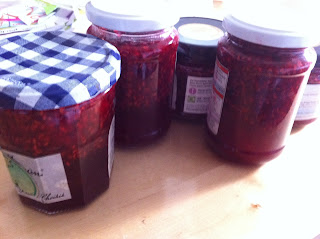 The end of the year is nearly here and I decided to inspect the damage
caused by my neglect on the plot.
The end of the year is nearly here and I decided to inspect the damage
caused by my neglect on the plot.I was pleased to see that overall it was not too bad but in no way is the tidiness as good as Bernie’s which is dug and covered already. On my plot, a few hopeful weeds are clinging on and I need to tidy up generally. The manure I spread around the raspberries seems to be keeping weeds down but still needs hand weeding to get on top of any sneaky dandelions.
My own compost bins should be almost ready (she writes hopefully) and spreading that around once I've turned the soil should help nourish the earth and keep weeds down (unless it activates weed seeds that have been lurking in the compost). I can't see the likelihood of getting any help with that back breaking job.
I noticed we also had a massive pony poo delivery - I must nab a bit to mulch with. It should have rotted down by planting time. Not sure if I'll have time before Xmas though to transport it to the plot...
Mental note on general fertilisers: if you have rotted down root perennial weeds like bindweed and dandelions for fertiliser, don't forget and try to wash your hand in it at a later date. It is revoltingly stinky and it takes a lot of soap and hand gel to shift the lingering stench.
Looking around other plots, it looks like others seem to have put chard seedlings in. Too late for me. At least I have 3 PSB seedlings/ plants established. Admittedly this is a bad return on the 20 or so plug plants I started with but the way I see it these are strongest by natural selection.
I should have covered PSB as they have suffered pigeon damage. Maybe I’ll do it now (or after xmas) so they have time to recover in spring.
While it looks like rosemary is the only useable thing in the plot actually the Jerusalem artichoke is ready. I will leave in the ground until I’m able to use it as they go wrinkly quickly. Never the prettiest of veg, wrinkles don't enhance things.
I decided to try out a Jamie Oliver recipe:
2 handfuls of large Jerusalem artichokes or new potatoes
1 radicchio or treviso, outer leaves discarded (I left this out as I don’t like the bitterness)
3 little gem lettuces, leaves washed, dried and stalks removed
a small handful of fresh flat-leaf parsley or chervil, leaves picked and finely sliced
extra virgin olive oil
8 rashers thickly sliced smoked streaky bacon or pancetta
1 small red onion, peeled and finely sliced
3 tablespoons balsamic vinegar
Scrub the Jerusalem artichokes and boil them in salted water until
tender. Once cool, cut them in half and set aside. Wash and dry salad leaves in
a salad
spinner.
Cut your bacon into slices and fry it. Add the sliced onion and the Jerusalem artichokes. Fry on a medium heat until the bacon is golden and crisp, the onion is sticky and soft and the Jerusalem artichokes have sucked up all the flavours and turned crispy.
Divide half the contents between four plates, then add 5 tablespoons of olive oil and balsamic vinegar to the pan, with a little pinch of salt and pepper. Mix everything together so the flavours improve and then pour immediately over the salad leaves waiting in the bowl. Toss lightly and quickly.
Incidentally the rosemary sprigs made pretty festive flourishes for the
Christmas table Cut your bacon into slices and fry it. Add the sliced onion and the Jerusalem artichokes. Fry on a medium heat until the bacon is golden and crisp, the onion is sticky and soft and the Jerusalem artichokes have sucked up all the flavours and turned crispy.
Divide half the contents between four plates, then add 5 tablespoons of olive oil and balsamic vinegar to the pan, with a little pinch of salt and pepper. Mix everything together so the flavours improve and then pour immediately over the salad leaves waiting in the bowl. Toss lightly and quickly.
In other cooking news, I made Trucklements relish with shop bought beetroot and horseradish (bought in chapel market). Not quite in the grow your own spirit but delicious. You can find the recipe here







































